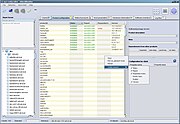| Revision as of 16:48, 17 November 2010 editLilHelpa (talk | contribs)Extended confirmed users, Pending changes reviewers413,676 editsm General fixes & Typo fixing using AWB← Previous edit | Revision as of 15:05, 3 January 2011 edit undoOpsidoc (talk | contribs)6 edits Update screenshotNext edit → | ||
| Line 1: | Line 1: | ||
| {{Infobox Software | {{Infobox Software | ||
| | name = opsi | | name = opsi | ||
| | screenshot = ] | | screenshot = ] | ||
| | caption = opsi management interface | | caption = opsi management interface | ||
| | developer = uib gmbh, Mainz, Germany | | developer = uib gmbh, Mainz, Germany | ||
Revision as of 15:05, 3 January 2011
 opsi management interface opsi management interface | |
| Developer(s) | uib gmbh, Mainz, Germany |
|---|---|
| Stable release | 4.0 / 1. oct 2010 |
| Repository | |
| Written in | Python Java |
| Operating system | Linux, Windows |
| Available in | English, French, German, Spanish, Turkish |
| Type | Network management System administration |
| License | GPL |
| Website | http://www.opsi.org/ |
Opsi (open pc server integration) is a software distribution and management system for Windows Clients, based on Linux servers.
Features
The core features of opsi are:
- Automatic operating system installation (OS Deployment)
- Software distribution
- Patch-Management
- Inventory (Hardware and Software)
- License Management / Software Asset Management
- Administrative Tasks (Configuration Management)
Developer and maintainer is the company uib gmbh in Mainz, Germany. The product is Open Source licensed under the GNU General Public License.
Supported client operating systems are Windows 2000, Server 2000, Windows XP, Server 2003. Support for Windows Vista, Server 2008 and Windows 7 is available, but subject to a Co-funding Project and not released as open source yet. For the installation of an opsi-server there are packages available for the Linux distributions Debian, Ubuntu and Suse.
Automatic operating system installation
Via management interface a client may be selected for OS-Installation. If the client boots via PXE it loads a boot image from the opsi-depotserver. This bootimage prepares the hard disk, copies the required installation files, drivers and the opsi client agent and starts finally an unattended OS-Installation. An OS-installation via Disk image is also supported.
Software distribution
For the automatic software distribution a client agent (the opsi-preloginloader) has to be installed on the client. This client agent starts at boot time, connects to the opsi configuration-server and starts if scheduled a script driven installation program (opsi-winst) which installs the required software on the client. During the installation process the user login can be blocked for integrity reasons. To integrate a new software packet into the software deployment system, a script must be written to specify the installation process. This script provides all the information on how this software packet has to be installed silent or unattended or by using tools like AutoIt or Autohotkey.
Patch-Management
The mechanism of the software deployment can also be used to deploy software patches and hotfixes.
Inventory (Hardware and Software)
The Hard- and Software Inventory uses also the opsi client agent. The Hardware Information is collected via calls to WMI while the Software Information is gathered from the registry. The inventory data are sent back to the opsi-configuration-server by web service.
License Management / Software Asset Management
The opsi License Management module supports the administration of different kinds of licenses like Retail, OEM and Volume licenses. It keeps track of the licenses that are used while the software deployment. Using the connection between the License Management and the software inventory, Software Asset Management reports on the number of free and installed licenses can be generated. The License Management module is part of a Co-funding Project and not released as open source yet.
Administrative tasks (Configuration Management)
The opsi client runs a script in a administrative context, which can be used also for configuration purpose. The opsi script interpreter supports:
- Start of programs and exit code detection
- Detection of the running OS, language and national settings as well as evaluation of Ini-files, text files, registry entries and environment variables
- Editing of registry, start menu and desktop entries, Ini-files, XML files and text files
- Editing of user specific profile registry entries and files (in case of not using 'roaming profiles')
- Calling external programs and scripts, catch and provide their output as variables for further processing
- File copy with or without version control
opsi-server
The opsi server provides the following services:
- The configuration-server stores the configuration data for the clients and the software packages. For the data storage a file- or LDAP based storage can be chosen. For administration of these data the configuration-server provides a graphical management interface via https as well as a command line interface.
- The depot-server stores software packages that may be installed by the clients. To provide support for multiple locations, multiple depot-servers may be controlled by one configuration-server.
- A TFTP-Server provides the boot images for the OS-Installations.
- A DHCP-Server may be integrated in the opsi-server
Management-Interface
For the management of opsi there is a graphical user interface, which is available as application as well as Browser Applet. Management is also possible with a command line tool or via web service.
Co-funding Projects
Even though opsi is open source, there are some components which are not free at the moment. These components are developed in a co-funding project which means that until the complete development costs are paid by co-funders, they are only allowed to use by the co-funders or for evaluation purposes.
References and sources
- http://www.opsi.org/features/
- http://www.opsi.org/license/
- http://www.opsi.org/screenshots/
- http://download.uib.de/opsi_stable/doku/opsi-manual-en.pdf, Chapter opsi-admin